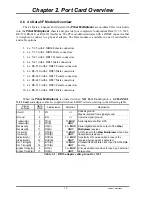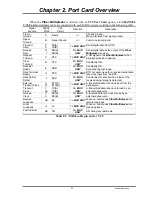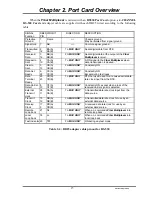
Chapter 1. Introduction
2
Version 1.2 Apr 2006
The
Fiber Multiplexer
E1
and
T1 Interface Cards
fully meet all E1 and T1 specifications
including ITU-T G.703, G.704, G.732, G.733, G.823 and G.824. The Bridge Interface Card meets
all Ethernet specifications for IEEE802.3 and IEEE802.3u.
Each
4-CHANNEL Port Card
features diagnostic capabilities for performing local loop
back or remote loop back (except for Ethernet Bridge card). The loop back function is controlled by
the front panel LCD menu, terminal mode (RS-232 console) or when the SNMP option board is
installed via Telnet or SNMP set commands.
Up to five clock source selections are provided. Without the external clock card option, the
unit operates from an internal free running oscillator. When the external clock card option is
installed, additional clock sources may be selected from the clock card's own internal oscillator or
from an external clock references for E1 PCM, E1 TTL, T1 PCM, or T1 TTL. All E1 and T1
equipment may connect to the
Fiber Multiplexer
without regard to master or slave timing. The
Fiber Multiplexer
is completely transparent to clocking and data transmission. This makes
configuration of the MUX extremely easy.
The Fiber Multiplexer provides optical interfaces (1+1) that are completely redundant and hot
swappable. By utilizing a modular design, fiber type (single mode or multi mode), the optical power
margin requirement and connector type can be easily chosen at installation time. This provides an
extremely flexible main unit which is not tied to a fixed optical interface. When two optical
modules are installed, the secondary module is in "standby", in case of any failure in the primary
path. If the primary fiber path fails, the switchover time to the secondary fiber is less than 50
milliseconds (industry standard). The automatic fall over function of the fiber allows the fiber to
continue to run in the secondary fiber, even after primary fiber connection is restored. This will
avoid another 50 millisecond loss of transmission on all channels. The fiber path can also be forced
from primary to secondary or back through the LCD menu or terminal console.
When the
Fiber Multiplexer
is ordered with an optional
SNMP Card
, the card is installed
inside the chassis. Configuration is accomplished via local control on the asynchronous RS-232 port
with a standard VT-100 terminal, via Ethernet and Telnet, or via any standard SNMP network
management software over Ethernet. The
Fiber Multiplexer
also has a Windows™ based GUI
management program that communicates with the
Fiber Multiplexer
via SNMP protocol to
display all status in real time, configure the unit, provides performance monitoring, and display
alarm buffers and real time trap messages. If the
SNMP Card
option is not installed, local and
remote management is still possible via the unit's internal menu system accessible from the front
panel LCD and menu keys, or via the asynchronous RS-232 port with a standard VT-100 terminal.
The
Fiber Multiplexer
also includes the ability to do in-band remote configuration. Once
the fiber optic link has been established, the remote unit may be configured or status checked from
the local unit using any of the available management options.









































